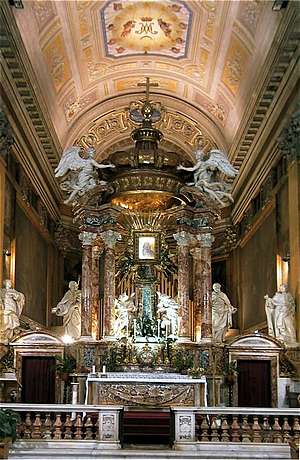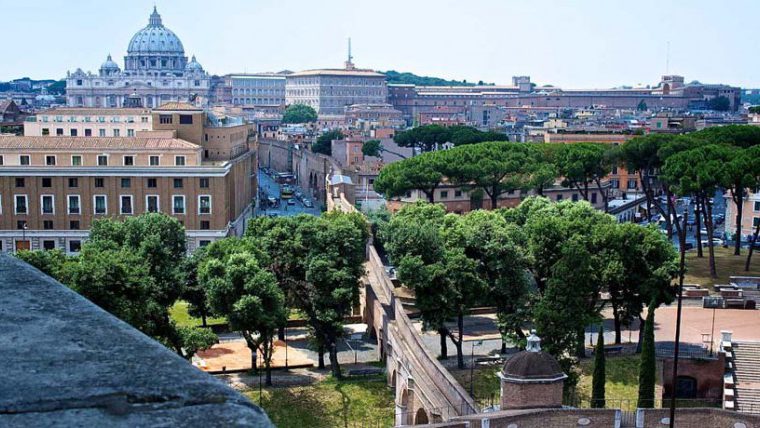One of the largest sites of the “Vanished Rome”, disappeared as a result of the radical restructuring of the area surrounding the Vatican in 1930, when the whole central part of the district was dramatically demolished to open a very wide avenue, Via della Conciliazione. The name has Saxon origin (Burg is a small village surrounded by a wall), in fact the number of Saxon students living in this Ward was very high. It arises from the camps of pilgrims around the burial place of the Apostle Peter, where little by little began to arise charity centres and hostels. Pope Leo IV (8447-855) then erected a wall around it to protect the Civitas Nova.
The presence of St. Camillus
In the summer of 1596 an epidemic kneels down the city of Rome. The Pope ordered every Cardinal to support the assistance of the infirm in their own parish. To Camillus and his companions were entrusted the poor infirm of Borgo S. Angelo, Our Saint already being then known as the “father of all the poor.” The Camillians divide the tasks this way: two are constantly in the company of the doctor to take account of all that is sorted to the infirm, other two visit and help the dying; eight of them go instead morning and evening with many porters carrying all the necessary for the assistance, dispensing door to door as ordered by the physician.
What remains
The Borgo can be “resuscitated” only through incisions in the books published before the demolition. The parts that remain, especially in the northern half, still show the original road system made of long streets also called “borghi”.
The Renaissance Church of St. Mary in Traspontina was saved from demolition, as well as the fountain which, form a square that no longer exists, was moved to St. Andrea della Valle.
To see
 St. Mary in Traspontina: lthe church was founded in the sixteenth century to replace an older one, demolished by Pius IV, because it represented an obstacle to the trajectories of Castel Sant’Angelo’s bombards. For the same reason the dome is very flattened. The building’s architect was Ottaviano Matte from Bologna, who also built the first nucleus of the Palazzo del Quirinale.
St. Mary in Traspontina: lthe church was founded in the sixteenth century to replace an older one, demolished by Pius IV, because it represented an obstacle to the trajectories of Castel Sant’Angelo’s bombards. For the same reason the dome is very flattened. The building’s architect was Ottaviano Matte from Bologna, who also built the first nucleus of the Palazzo del Quirinale.
Magnificent buildings of severe style were built by prelates and nobles in the early sixteenth century. The most important are: Palazzo Branconio dell’Aquila, designed by Raphael Sanzio, Palazzo Caprini by Donato Bramante (a house later acquired by Raphael, and that later became part of Palazzo dei Convertendi); Palazzo Castellesi, built by Cardinal Adriano Castellesi, attributed to Andrea Bregno or Bramante and a copy on a smaller scale of the Palazzo della Cancelleria; Palazzo dei Penitenzieri, by Baccio Pontelli. These three buildings opened onto a small square (Piazza del Cardinale di San Clemente, più tardi Piazza Scossacavalli), which became the largest in the Borgo district.
Nearby
Piazza San Pietro: the famous square, a remarkable example of baroque architecture and urbanism, is dedicated to the eponymous Saint and it is a daily meeting point for thousands of Catholic faithful from all around the world. The space of the square consists of two parts: the first one has the shape of an inverted trapezoid whose largest side corresponds to the facade with specific perspective motives; the second one is larger, oval-shaped with the Vatican obelisk in the centre. An imponent architraved colonnade unifies the two large spaces. In front of the square itself there is another space that serves as a vestibule (Piazza Rusticucci, now Piazza Pio XII) and that leads to the twentieth century’s Via della Conciliazione.
Castel Sant’Angelo: dalso known as the Mausoleum of Hadrian, it is connected with the Vatican through a fortified corridor called “Passetto”. The castle has been radically changed several times during the Middle Ages and Renaissance. It is located on the right bank of the Tiber, opposite the Pons Aelius (now Ponte Sant’Angelo) within easy walking distance from the Vatican, in the Borgo district.















Camillians on Facebook
Camillians on Twitter
Camillians on Instagram